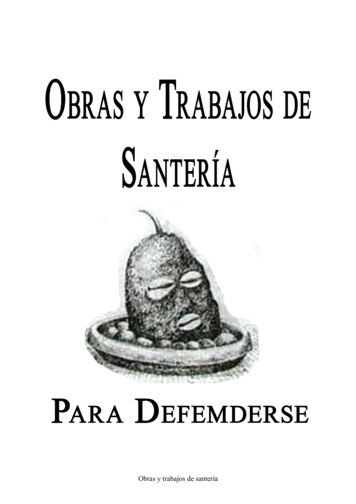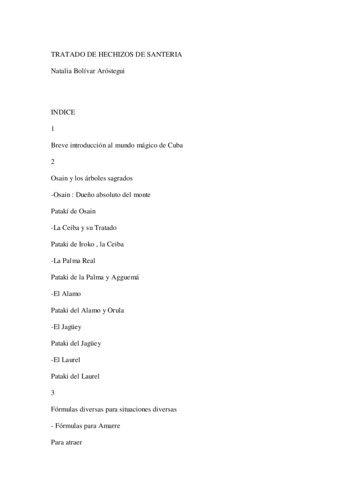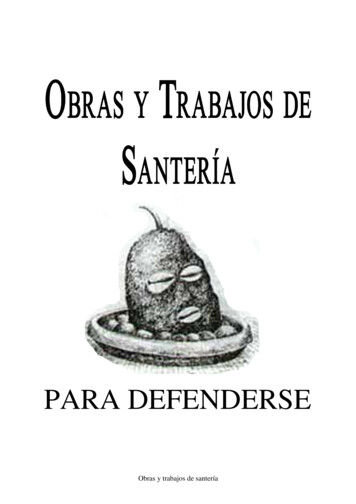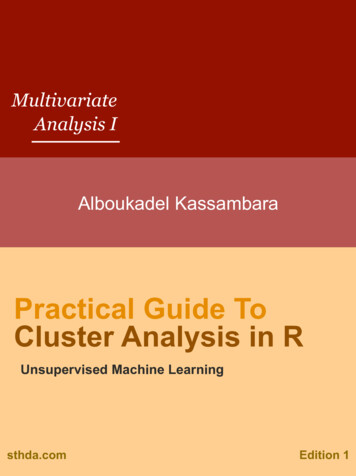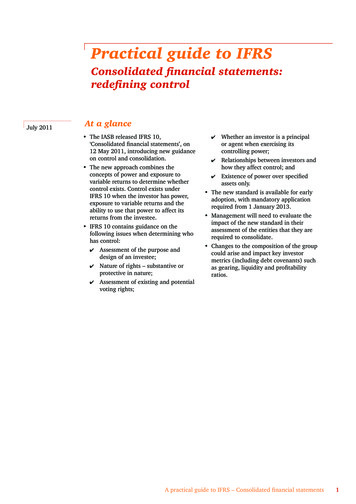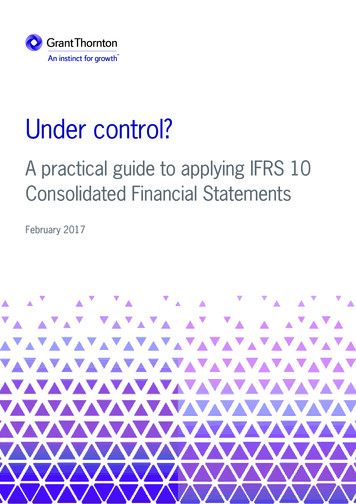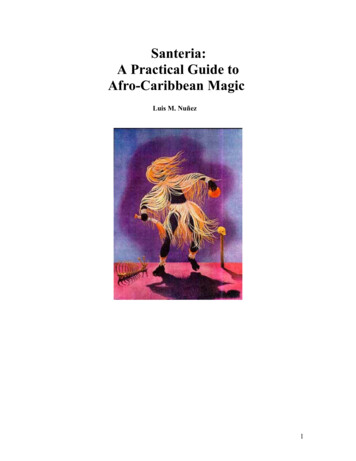
Transcription
Santeria:A Practical Guide toAfro-Caribbean MagicLuis M. Nuñez1
Table of ContentsIntroduction.Chapter 1.Historical notes.Chapter 2.Ceremonies.Chapter 3.The Sacrifice.Chapter 4.The Gods I.Chapter 5.The Gods II.Chapter 6.The Gods III.Chapter 7.The Gods IV.Chapter 8.The Oracles I.Chapter 9.The Oracles II.Chapter 10.The Oracles III.Chapter 11.The Oracles IV.Chapter 12.Talismans, Spells & Implorations I.Chapter 13.Talismans, Spells & Implorations II.2
IntroductionSanteria is not an archaic religion. It is a vibrant force with fivehundred years of continuous history in the Western Hemisphere.Its African roots go back at least as far as Christianity's.Santeria has millions of followers spread across the United States,the Caribbean, Central, and South America. There is Voodoo inHaiti, Macumba in Brazil and Candomble in the Northern coastsof South America. Its adherents come from all walks o f life;doctors, lawyers, politicians, thieves and pimps. All those whoseek the power to control their own lives and want to lead them inaccord with the deepest parts of their beings are candidates forinitiation into Santeria. As the traditional belief systems of theWestern world cease to provide a direct emotional involvementwith the mysteries of life, more and more people are turning to thethrobbing of the Santeria drums. It is a religion of trance, mystery,posse ssion, blood and sex. What follows is a brief glimpse intoSanteria. If you want to know more, go to the ceremonies, burnthe candles and dance to the drums. Skin color or language are nobarriers. The ancient gods will recognize their own.Chapter OneHISTORICAL NOTESSanteria's roots are in Africa, in the Yoruba religions native toNigeria. It was brought to the New World by the hundreds ofthousands of men, women and children who were hunted downand sold as slaves.The African religions had to undergo severe transformations inorder to survive. The changes that led to Santeria began in 1517,when Yoruba slaves had their first bitter taste of Catholicism inCuba.It is its Catholic content which gives Santeria its peculiar flavor.The combination results in a Santero being a devout RomanCatholic at the same time he or she is sacrificing a rooster to acement image of Elegua enthroned behind the front door.There are no records. There are only stories, echoes of voices longdead.3
The slave is brought to the new land. No longer a human being,the slave is sold and traded like a beast of burden. If the Master iskind, the slave will eat and live to work. If the Master is not, theslave will work until the slave dies.Night brings an old Yoruba song. A homemade drum answers. Achorus forms. More drums are brought out. The old movementsare recalled. The dancing starts. Chants and dances fromquarrelling African tribes join and make love to each other. Therhythms unite, transform and give birth to something new.The herb man looks after the sick. He sees the future. Prayers.Offerings. Sacrifices. He knows what foods the gods like, whatwomen attract them. Enemies are killed by a handful of powder.The white man in the black cassock comes. There is a Jesus. Hewas tortured and killed. His mother cries. The slaves understandgrief and death.The white god doesn't talk. The white god does not come to visit.The white god does not like the things that the earth gives withsuch love. No singing. No dancing. No food. No perfume. He hatesthe feel of soft velvety flesh and laughter in the night. The whitegod makes no miracles.The old Yoruba priest teaches the young the ancient rites.Secretly. They are treasures.Nannies croon African Apatakis. White babies fall asleep, thestories of the gods in their ears. The babies grow up. They dance.They believe.White men have black lovers. Beautiful black women bite theirears. They learn to respect Chango. They do not provoke Elegua.The Spanish Inquisition comes and kills and burns. They say thereis only one god.The slaves smile and lie. They worship Chango, Obatala or Oshunas they kneel in church. They believe in the white god and saintsas well. The more love and respect given to all the gods, thegreater their protection.Elegua, the playful messenger of the gods, cheerfully becomes theHoly Child of Atocha. Oshosi, the fierce god of war, shrugged his4
shoulders and became Saint Norbert. Oshun, the hip-swinginggoddess of those who know how to make love with skill andpassion, became Our Lady of Charity (La Caridad del Cobre).Chango, the invincible warrior chief, the whoring god of stormand lightning, showed his sense of humor. He turns into SaintBarbara.Everyone felt much more protected now that Chango was awarrior as well as a female Saint inside the church. No one fooledanyone. The slave owners saw that, after a religious festival (a "golpe de Santo") there was peace and harmony in the sugarplantations. Many white mothers had their child brought back tohealth by a black herbalist. Young women swore about theeffectiveness of love philters and showed off their handsomehusbands as proof. The priests thought about the recent slaveuprisings in Haiti and the accompanying massacre of thepriesthood and assured the laity that a little drumming in thenight was absolutely harmless.Santeria was born. No one really paid much attention.Chapter TwoCEREMONIESThe Rule of Osha, as Santeria is formally known, has no writtencanon. Its traditions are passed on orally to the initiates. Thewritten records in existence are either direct transcriptions fromthe oral tradition taken from initiates by interested researchers orfrom the notebooks in which a godmother or godfatherlaboriously wrote, with a smeary pencil, awful grammar andspelling, the finer points to be remembered during the ceremonies.The Lucumi language that the initiate in Santeria, the "asentado",is supposed to learn and practice is passed on in the same way.Santeria has many variations according to the locality in which itis practiced. Distance and necessity make many of the practicesvary wildly from each other. However, certain common threadsrun through all practices and make it possible to come up withwhat may be called a "generic" ceremony.5
The CeremonyIt is Saturday. Everyone arrives early, dressed in their patronSaint's, their Orisha's, favorite colors and bringing the collars(Ilekes) and bundles and boxes containing the sacrificial animalsand special foods and offerings needed for the ceremony. Theceremonies are long and exhausting. They can last all night andinto Sunday morning.A large comfortable room has been reserved in the house. Thetime passes in conversation, jokes and anecdotes. The altar isplaced in a prominent position within the ceremonial area.Commonly, images of Christ and St. Barbara are prominentlyfeatured. Spread out before each image is a large ceramic souptureen with a cover, usually decorated in a very rococo style.These tureens contain the stones (Otanes) sacred to the Orishasand the consecrated cowrie shells (Dilogun) used in the shelloracle (Medilogun).Upon the mat covering the floor before the altar, the participantsplace the fruits, vegetables, cooked foods and the sacrificialanimals they brought to the ceremony. There are also containersof Chequete (a drink made from sour orange juice, molasses, cornmeal and fresh coconut milk). Bottles of aguardiente (anextremely strong drink distilled from sugar cane juice) are alsoplaced on the mat as an offering to the Orishas. The officialconducting the ceremony, either a high ranking bishop (Babalawo, or Iyalocha, if a woman), or a common priest (Santero orSantera) will fill his or her mouth with the aguardiente and sprayit over the gathering as a blessing and to quiet those who havebeen possessed by an Orisha during the ceremony.The conversation dies down at a signal from the Babalawo.Everyone settles down in front of the altar. The Babalawo holdsup a container of Omiero (a mixture of rain water, river water, seawater and holy water; aguardiente, honey, corojo butter-extractedfrom the hard nuts of the corojo palm, cocoa butter, powderedeggshell, pepper and various other herbs and ingredients particularto the mixture's purpose. It is brewed by immersing a live coalwrapped in a fresh taro (Malanga) leaf into the mixture, which hasbeen steeping since the previous day).6
The container is presented to the four cardinal points and a smalloffering is made to each by spilling a bit of the Omiero. TheBabalawo faces the altar and offers the Omiero to the Orishas,asking them to bestow their magical powers (Ashe) upon him. Alittle Omiero is then spilled at the room's entrance. The Babalaworeturns to the center of the gathering and spills Omiero on thefloor three times. The mixture is then offered to whomever wouldlike to drink. Almost everyone does.The Babalawo then draws the required symbols on the floor tosummon the Orishas. They are drawn with powdered eggshell mixed with earth fromthe roots of the favorite tree or plant of the house's tutelary Orisha.The symbol is blessed and sprinkled with corn meal. A candle islit at prescribed points. No one walks on these designs or stepsover them.The preliminaries being over, the youngest initiates (young interms of time since their initiations into Santeria), along withthose that aspire to join, back into the room, their faces away fromthe altar. The make obeisance by laying face down on the floorwith their heads towards their godmother or godfather, the personsponsoring the novice and who may or may not be conducting theceremony. This person or persons, in turn salutes the Orishas andblesses the new initiates and the novices. The blessings made, thegodfather or godmother stands. The drumming begins.Sometimes a participant is immediately possessed by an Orisha.At the moment of possession, the personality traits of thecontrolling Orisha become clearly manifested. Shaking andshuddering of the whole body are followed by very strongconvulsions. The possessed individual falls on the floor.The physical symptoms cease. Utter calm is reflected in the"montado"'s face (literally, he who is ridden. The act ofpossession). Voice, mannerisms and gestures change completely.The personality of the "caballo" (horse) ceases to exist. Thepersonality of the Orisha has completely taken over the believer'sbody.Nearby persons restore the "caballo"'s calm by blowing into his orher ears and mouth. Cocoa butter or corojo butter are rubbed on7
the person's hands and feet. If the trance becomes too violent, the"caballo" may be injured. It is the responsibility of those aroundthe possessed individual to ensure his or her well being.After the initial crisis is over, the Orisha's control over thepossessed body becomes stronger. The Orisha dances to thewelcoming beat of his or her specific rhythm and chant and"cleans" (purifies and blesses) those present. If the ceremonyincludes an animal sacrifice, the Orisha blesses those present bytearing or biting off the heads of sacrificial birds and sprinklingthem with the blood.If the Orisha is in a good mood, his "children" (those initiated tothat particular Orisha) will joke and dance with the Saint. If theOrisha is in a bad mood or comes to punish someone, there is aprofound silence. Everyone respectfully listens to the scolding.The Orishas speak briefly and get directly to the point. Theyprefer to communicate through the cowrie shell oracle or thecoconut oracle (Biague).The trance may last for seconds or for the entire ceremony. Thetrance's end comes spontaneously, although the godmother orgodfather of the possessed person may have to intervene at timesand prevent the possession from lasting too long a time. This isspecially true in the case of novices whose trance capacity is notwell known. Rarely can the possessed person remember what theydid or said.The Initiation (The "Asentado")The details of each initiation ceremony vary according to theOrisha who will become the "parent" of the person being initiatedinto Santeria. The following information is a composite obtainedfrom various sources and may be described as a "generic"initiation.The first Orishas to be "asentados" (literally, seated upon) thenovices head are: Obatala, Chango, Yemaya, and Oshun.Petitioning these Orishas for protection, offering them bloodsacrifices and becoming possessed by them mark the entrance ofthe novice into Santeria.8
The novice has no say in selecting the Orisha whose "child" hewill become. The relationship is revealed through consulting theoracles, the physical characteristics peculiar to the "children" of aparticular Orisha and through the direct intervention of the Orishaas he or she possesses a person and lays claim to that person priorto his or her novitiate."I remember that the first thing I had to do was to get together themoney. And it was a lot! An asiento is expensive. The big one isthe fee to the Babalawo, but there's also all the food to buy and theaguardiente. Not to mention all the new clothes I had to buy. Youhave to have all new clothes, you know, to be clean."Both the money and the new wardrobe are turned over to thenovice's godmother or godfather. It is this sponsor whoadministers the funds.The current cost of an initiation in New York or in Miami caneasily run from three to five thousand dollars. The cost isdetermined by the Orisha, or so it is said."My godfather came and told me when the 'asiento was going tobe. I was very excited. I was frightened, but I was mostly excited.I packed up my things and moved to my Babalawo's house. I wassupposed to be there a week, but I had problems at work and I hadto go back to work in four days."If the novice is a girl who has reached the age of menstruation, thedate of the "asiento" and of its accompanying rites must notcorrespond with that of her period. The proximity of amenstruating woman to an Orisha is considered sacrilege."The Babalawo sat me down in his room. He made me sit on amat. He took out his shells and sang to them and shook them up.Then, he had me blow
Talismans, Spells & Implorations II. 3. Introduction. Santeria is not an archaic religion. It is a vibrant force with five hundred years of continuous history in the Western Hemisphere. Its African roots go back at least as far as Christianity's. Santeria has millions of followers spread across the United States, the Caribbean, Central, and South America. There is Voodoo in Haiti, Macumba in .
